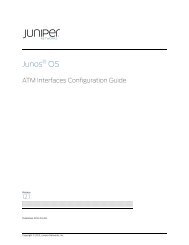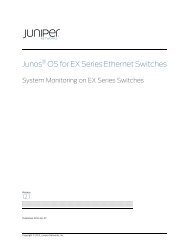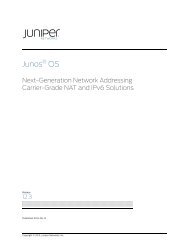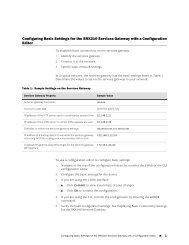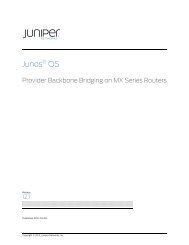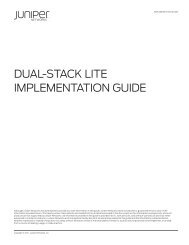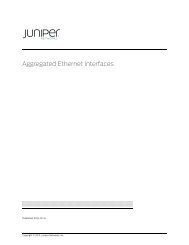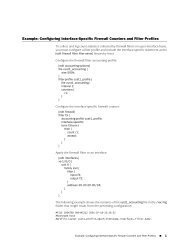Spanning Tree Protocol on Juniper Networks MX Series 3D ...
Spanning Tree Protocol on Juniper Networks MX Series 3D ...
Spanning Tree Protocol on Juniper Networks MX Series 3D ...
Create successful ePaper yourself
Turn your PDF publications into a flip-book with our unique Google optimized e-Paper software.
<str<strong>on</strong>g>Spanning</str<strong>on</strong>g> <str<strong>on</strong>g>Tree</str<strong>on</strong>g> <str<strong>on</strong>g>Protocol</str<strong>on</strong>g><br />
<strong>on</strong> <strong>Juniper</strong> <strong>Networks</strong> <strong>MX</strong> <strong>Series</strong> <strong>3D</strong> Universal Edge Routers<br />
another source, such as a lower bridge ID or lower path cost than it currently has stored<br />
for the port, it relinquishes its claim as the CIST regi<strong>on</strong>al root.<br />
During initializati<strong>on</strong>, a regi<strong>on</strong> might have many subregi<strong>on</strong>s, each with its own CIST regi<strong>on</strong>al<br />
root. As bridges receive superior IST informati<strong>on</strong>, they leave their old subregi<strong>on</strong>s and join<br />
the new subregi<strong>on</strong> that c<strong>on</strong>tains the true CIST regi<strong>on</strong>al root. In this manner, all subregi<strong>on</strong>s<br />
shrink, except for the <strong>on</strong>e c<strong>on</strong>taining the true CIST regi<strong>on</strong>al root.<br />
All bridges in the MST regi<strong>on</strong> must agree <strong>on</strong> the same CIST regi<strong>on</strong>al root to operate<br />
correctly. Therefore, any two bridges in the regi<strong>on</strong> <strong>on</strong>ly synchr<strong>on</strong>ize their port roles for an<br />
MST instance if they c<strong>on</strong>verge to a comm<strong>on</strong> CIST regi<strong>on</strong>al root.<br />
Bridge priority can be separately specified in the c<strong>on</strong>figurati<strong>on</strong> for each MSTI.<br />
Multiple bridge domains can corresp<strong>on</strong>d to the same MSTI. A maximum of 64 MSTIs can<br />
be c<strong>on</strong>figured. The logical ports (e.g. ge-0/0/0.1) in a bridge domain can bel<strong>on</strong>g to a<br />
range of VLANs; therefore, an MSTI can map to VLAN ranges.<br />
Each MSTI <strong>on</strong>ly spans the VLANs of those physical interfaces specified under the interface<br />
that are within the STP c<strong>on</strong>figurati<strong>on</strong>.<br />
Operati<strong>on</strong>s Between MST Regi<strong>on</strong>s<br />
If there are multiple regi<strong>on</strong>s or legacy STP bridges within the network, MSTP establishes<br />
and maintains the CST, which includes all MST regi<strong>on</strong>s and all legacy STP bridges in the<br />
network. The MST instances combine with the IST at the boundary of the regi<strong>on</strong> to<br />
become the CST.<br />
The IST c<strong>on</strong>nects all of the MSTP bridges in the regi<strong>on</strong>. It appears as a subtree in the<br />
CIST that encompasses the entire bridged domain. The root of the subtree is the CIST<br />
regi<strong>on</strong>al root. The MST regi<strong>on</strong> appears as a virtual switch to adjacent STP bridges and<br />
MST regi<strong>on</strong>s.<br />
The following shows the c<strong>on</strong>figurati<strong>on</strong> statement syntax for MSTP.<br />
[edit]<br />
routing-instances {<br />
instance1 {<br />
instance-type virtual-switch;<br />
bridge-domains {<br />
bd-vlan-10 {<br />
domain-type bridge;<br />
routing-interface irb.0;<br />
interface ge-3/0/0.0;<br />
interface ge-3/0/1.0;<br />
}<br />
bd-vlan-11 {<br />
domain-type bridge;<br />
routing-interface irb.1;<br />
interface ge-4/0/0.0;<br />
interface ge-4/0/1.0;<br />
}<br />
bd-vlan-12 {<br />
domain-type bridge;<br />
16<br />
Copyright © 2013, <strong>Juniper</strong> <strong>Networks</strong>, Inc.





